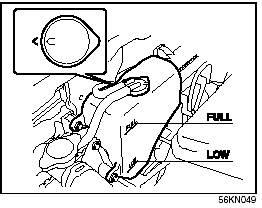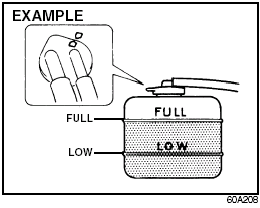Engine Coolant


Selection of Coolant
To maintain optimum performance and durability of your engine, use SUZUKI Genuine Coolant or equivalent.
This type of coolant is best for your cooling
system as it:
• Helps maintain proper engine temperature.
• Gives proper protection against freezing and boiling.
• Gives proper protection against corrosion and rust.
Failure to use the proper coolant can damage your cooling system. Your authorized SUZUKI dealer can help you select the proper coolant.
CAUTION:
To avoid damaging your cooling system:
• Always use a high quality ethylene
glycol base phosphate type coolant
diluted with distilled water at the
correct mixture concentration.
• Make sure that the proper mix is 50/ 50 coolant to distilled water and in no case higher than 70/30. Concentrations greater than 70/30 coolant to distilled water will cause overheating conditions.
• Do not use straight coolant nor plain water.
• Do not add extra inhibitors or additives.
They may not be compatible with your cooling system.
• Do not mix different types of base coolants. Doing so may result in accelerated seal wear and/or the possibility of severe overheating and extensive engine/automatic transaxle damage.
Coolant Level Check
Check the engine coolant level at the reserve tank, not at the radiator. With the engine cool, the engine coolant level should be between the “FULL” and “LOW” marks.
Adding Coolant
If the engine coolant level is below the “LOW” mark, more engine coolant should be added. Remove the reserve tank cap and add engine coolant until the reserve tank level reaches the “FULL” mark. Never fill the reserve tank above the “FULL” mark.
CAUTION:
• The mixture you use should contain
50% concentration of antifreeze.
• If the lowest ambient temperature in your area is expected to be – 35°C (–31°F) or below, use higher concentrations up to 60% following the instructions on the antifreeze container.
• When putting the cap on the reservoir tank, line up the arrow on the cap and the arrow on the tank. Failure to follow this can result in coolant leakage.

WARNING:
Engine coolant is harmful or fatal if
swallowed or inhaled. Do not drink
antifreeze or coolant solution. If swallowed,
do not induce vomiting. Immediately
contact a poison control
center or a physician. Avoid inhaling
mist or hot vapors; if inhaled, remove
to fresh air. If coolant gets in eyes,
flush eyes with water and seek medical
attention. Wash thoroughly after
handling. Solution can be poisonous
to animals. Keep out of the reach of
children and animals.
Coolant Replacement
Since special procedures are required, we recommend you take your vehicle to your SUZUKI dealer for coolant replacement.
See also:
Cargo & Towing
There's up to 28.4 cubic feet of cargo room behind the backseat. Maximum
cargo volume totals 70.8 cubic feet, but it takes a few steps to get there. You
have to fold down the second row's backrest ...
Assist Grips (if equipped)
Assist Grips (if equipped)
Assist grips are provided for convenience.
CAUTION:
To avoid damaging the assist grip
and the molded headlining, do not
hang down the assist grip. ...
Listening to a CD
• CDs or CD-ROMs carrying no mark (A)
cannot be used.
• Some discs previously recorded in CDR\
CD-RW format may not be used.
• A CD is inserted with its label facing
upward.
• When t ...
